Overclocking a CPU to 7 GHz with the science of liquid nitrogen
I overclocked a CPU to 7 GHz on liquid nitrogen and all I got was this cool article.
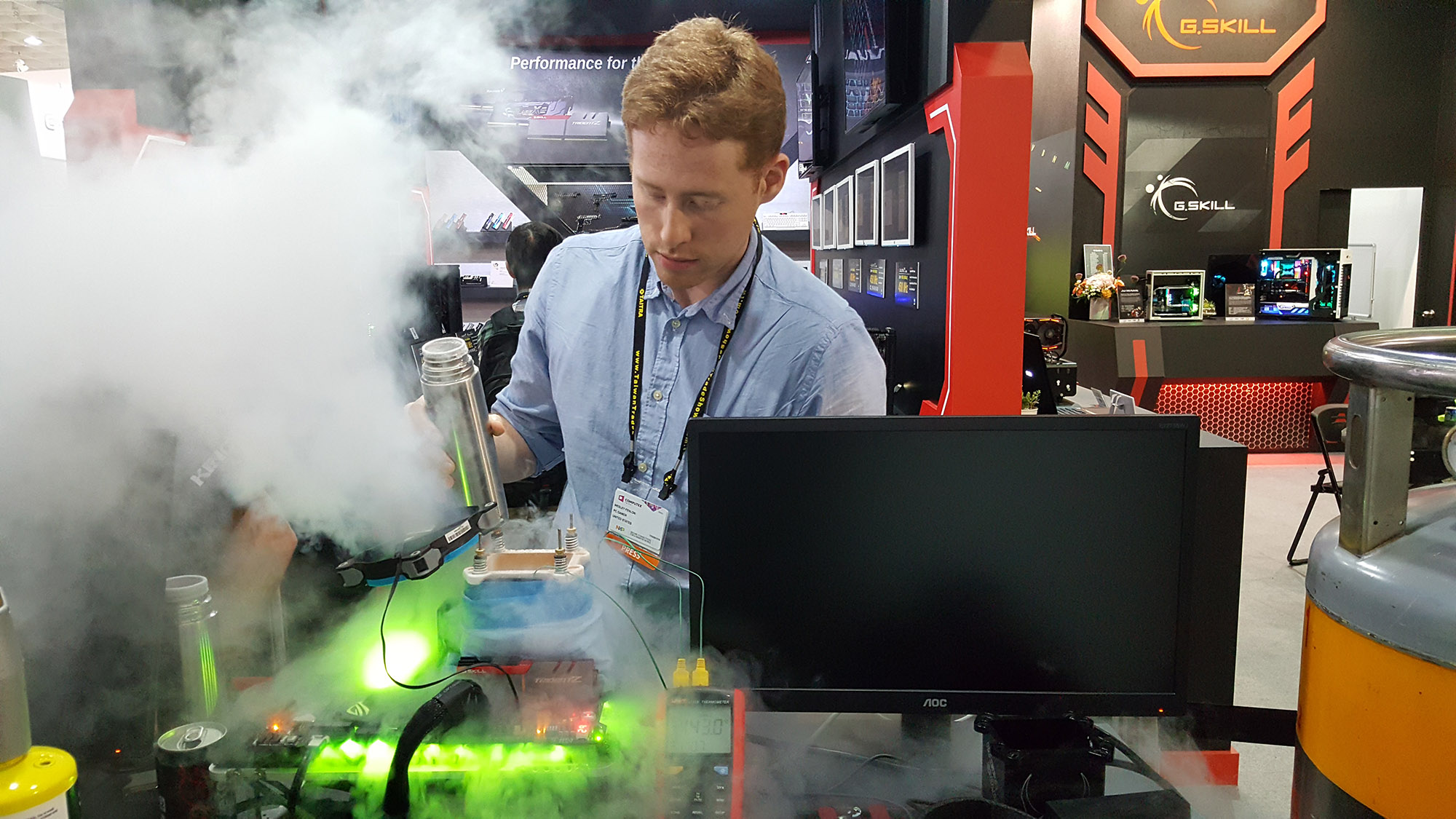
Overclocking is perfectly safe, I always tell people. I usually don't mention the time I fried a CPU by accidentally giving it a massive unintended jolt of extra voltage. They don't need to know about that. Overclocking really is easy! And perfectly safe, most of the time. But I always assumed the realm of extreme overclocking using liquid nitrogen was as flashy and risky as it looked—and it looks pretty damn flashy, as a massive block of ice spews vapor off the top of a naked motherboard.
Turns out I was mostly wrong. Thanks to my recent trip to Computex, I can cross liquid nitrogen overclocking off my bucket list. HWBot director Pieter-Jan Plaisier explained the science and technique of liquid nitrogen overclocking, and together we took a CPU to 7GHz and lived to tell the tale. And the CPU lived, too.
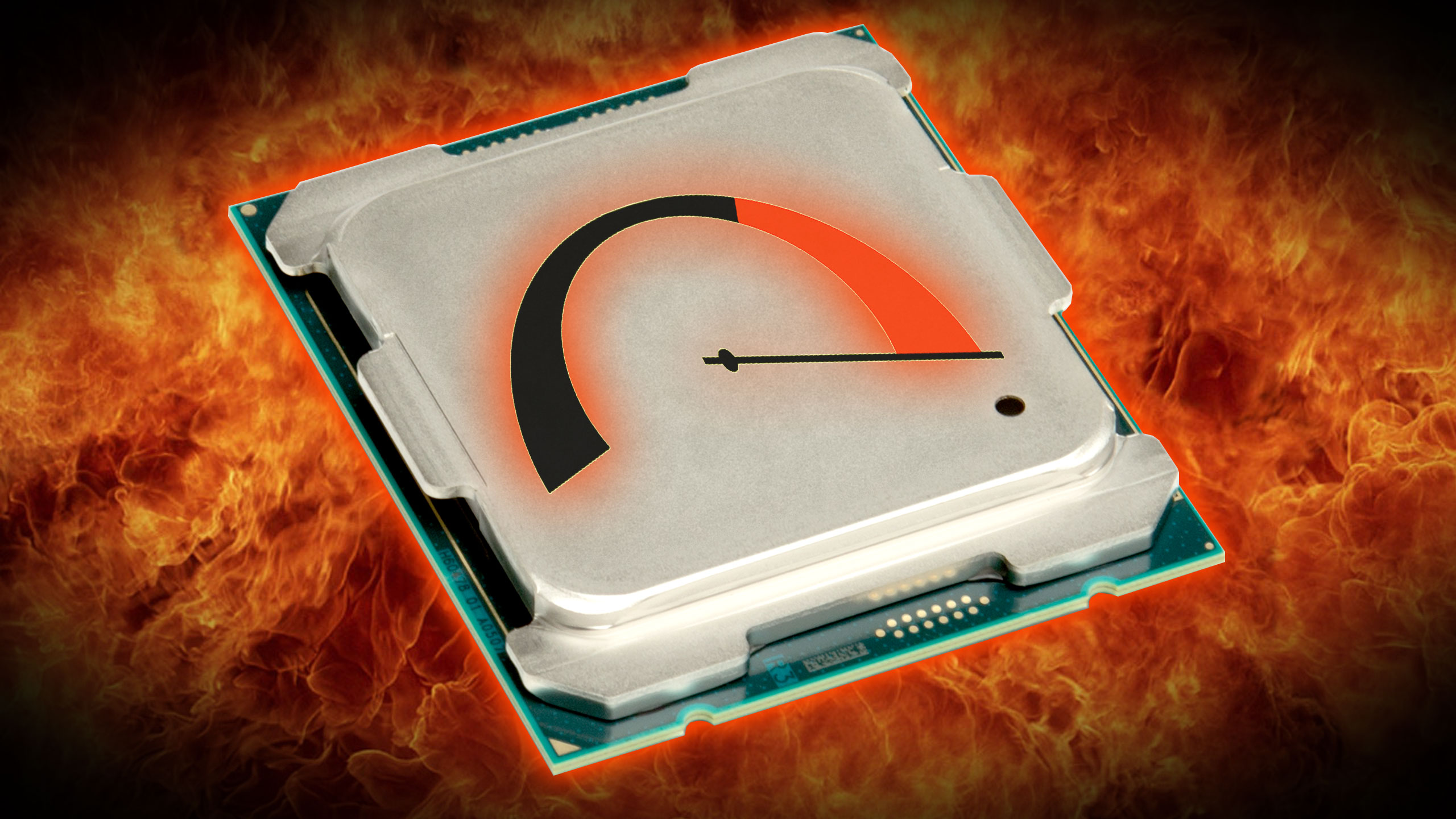
Want some more practical overclocking tips? Check out our guide to overclocking your Intel CPU.
If you've never followed extreme overclocking closely, you might be asking: why do they pour liquid nitrogen onto their computers? "We use a coolant-like liquid nitrogen to reduce any of the temperature limitations or power limitations," says Plaisier. "By cooling it down, we reduce its power consumption, and we reduce the temperature. The temperature has an effect on the overall frequency we can reach, and reducing the power consumption allows us to use higher voltages as well, which in turn gets us higher frequencies. You can see a power drop of something like 50 watts or something like that, just by cooling down the system."
Plaisier likens extreme overclocking to getting a new car and opening it up on the road to see how fast it can go. The insanely high numbers can be good for marketing for companies like Asus, who make motherboards with features specifically for low temperature overclocking. Some people criticize liquid nitrogen overclocking as being impractical, since you can't realistically pump LN2 through your system 24/7 (although it's been done). But that's not really the point. It's about learning how to push a piece of hardware to its limits, and that really is an intricate process.
How it works
The point of liquid nitrogen overclocking is to get your CPU way, way colder than it would normally be with an air cooler or a radiator. But the science behind reaching those low temps is pretty cool.
Instead of the usual heatsink, liquid nitrogen calls for a block that makes contact with the CPU's heat spreader and a "pot" for holding the liquid nitrogen as you pour it in. The setup we used was a heavy copper block with circular chambers drilled into the base. Those offer more surface area for the LN2 to fill in, helping you lower temperatures more quickly. The mass helps retain temperature. "The CPU heat gets transferred through the copper, then we cool down the copper again," Plaisier says. Now some basic science comes into play with the leidenfrost effect. Here's a quick primer.
So your CPU is running, producing heat. You pour in liquid nitrogen, which is very cold. "There's a small vapor layer between the surface of the copper here, and the nitrogen," says Plaisier. "So it bounces off very quickly. It's not very efficient." But even though the nitrogen has evaporated, it's still made the copper very cold. So how do you defeat the leidenfrost effect? With a blowtorch, obviously.
The biggest gaming news, reviews and hardware deals
Keep up to date with the most important stories and the best deals, as picked by the PC Gamer team.
"You torch the inside, creating an ice layer, which lifts the leidenfrost effect. We use the heat on the cold, we have condensation, but because it's so cold, it immediately forms an ice layer. With the same drop of nitrogen, it will be cooling a lot more effectively. So it's a bit of physics that goes into play."
Bringing the CPU temp down is as simple as pouring LN2 into the pot and watching the numbers drop until it reaches -196 degrees Celsius. Depending on what kind of overclocking you're doing, you may have to keep adding LN2 regularly—a heavy benchmark load, for example, will naturally heat up the CPU. But this is really just the basic setup for how liquid nitrogen cooling works; the actual overclocking process, as you'd expect, is much more involved.
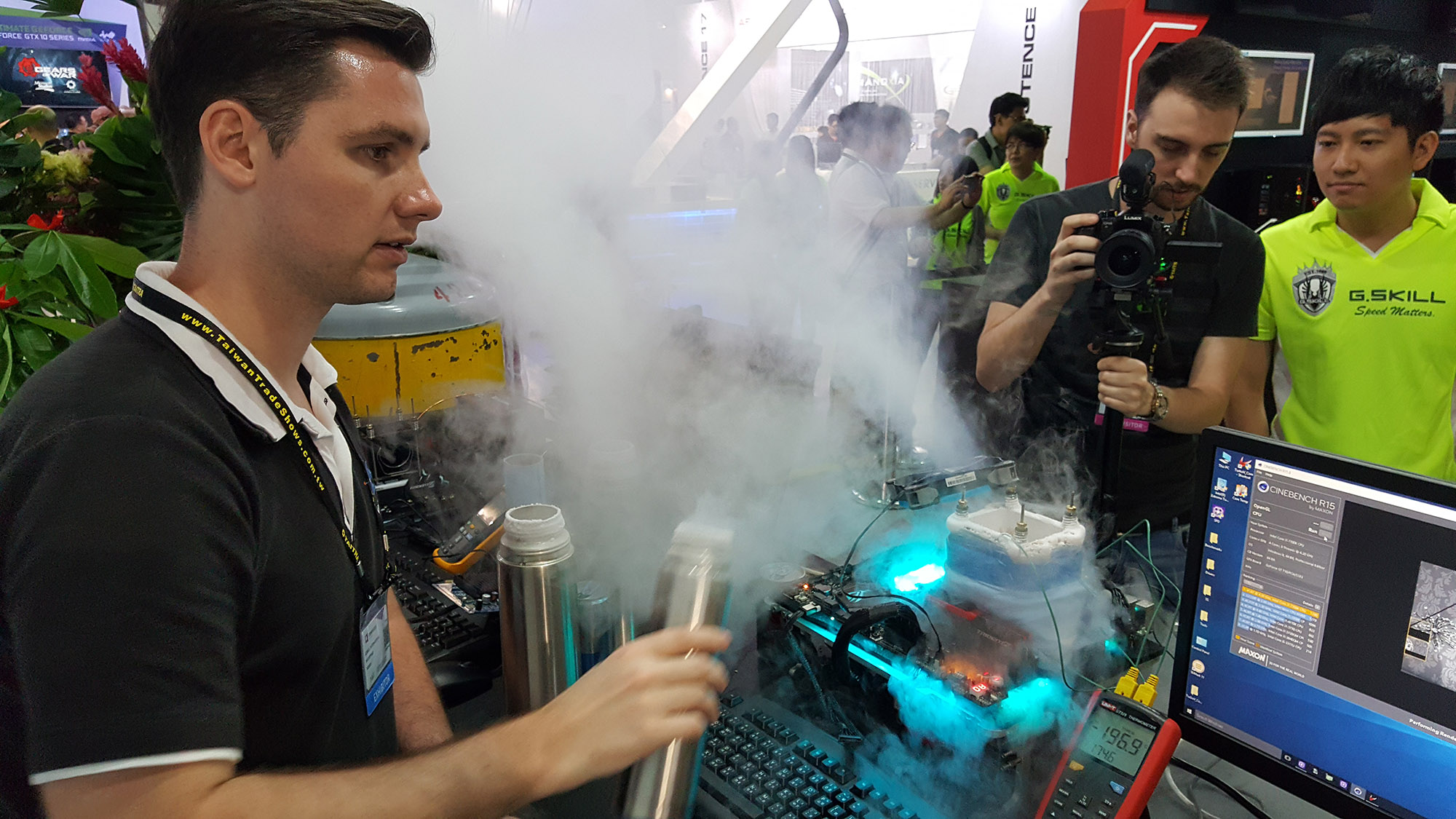
Extreme overclocking in action
The essence of overclocking is finding the balance of voltage and speed that guarantee a stable system. Extreme overclocking isn't much different, except you'll end up tweaking potentially dozens of discrete voltage and timing settings in the BIOS. Same idea, but massively more complex to learn. Thankfully, we were using an Asus motherboard with a pre-configured BIOS.
"The amount of knowledge that you need to get a chip like Kaby Lake up to 7 GHz is unimaginable," Plaisier says. "The good thing is that we have engineers in the motherboard companies figuring all this out, and making sure the BIOSes are ready for people that just want to try to see how far their chip can go. For example, this profile, they've configured the entire VRM for optimal power delivery. Technically you can configure all these yourself as well, but if you have to learn all these terms, your'e six months away. Another problem: a lot of the documentation about these kinds of settings is confidential. So not everyone even has access to all the information to even learn how to configure everything. You have a whole bunch of voltages which typically no one talks about. Internal PLL voltage, DMI voltage. Most people would not know where those are affected."
The extreme cold of liquid nitrogen unsurprisingly can have a variety of effects on PC components that weren't built for those temperatures.
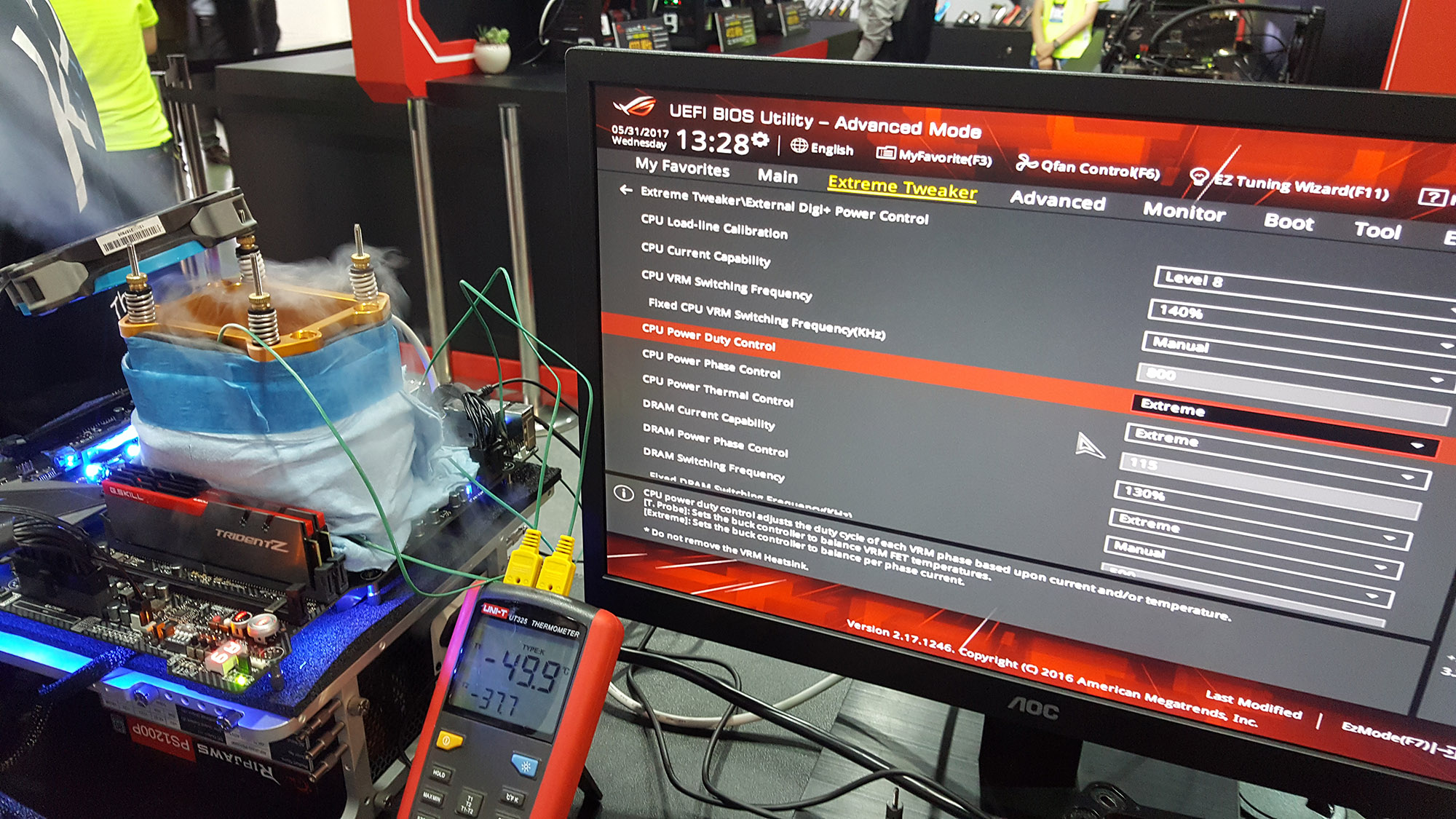
"In the past, there would be a lot of problems with the PCI interface," Plaisier says. "When you go below, say, -80 degrees, the PCI interface would stop working, so your system would not boot up anymore. Most recently, it would be the FIVR, the fully integrated voltage regulator, that you have on Broadwell-E and now Skylake-X as well. Essentially the power regulator is on the chip, and that's causing issues. Below a certain temperature it stops operating."
Recent CPUs are, luckily, much better at dealing with the cold. The Kaby Lake i7-7700K CPU we were overclocking with had no problems running at -196C, which means we don't have to micromanage much. That hasn't always been the case. Some CPUs will crash if they get too cold, which makes for incredibly challenging overclocking contests. The pro overclockers have to know exactly when to pour LN2 onto the CPU as it heats up during a benchmark, keeping it cold enough for maximum performance, but not overpouring and dropping the temperature so low it causes a crash. Still, cold temperatures for the system in general can cause crashes, and rebooting at -196C is less likely to go well.
Generally, there are two big terms to know when liquid nitrogen overclocking: a cold bug and a cold boot bug.
"The cold bug is when your system stops operating altogether. Below that temperature it cannot operate. The cold boot bug is when your system can no longer initialize. Typically your cold bug would be a bit lower than your cold boot bug. When you're throwing a workload at it, you can go to, say, -160C, but when you reboot, there's no more workload, all of a sudden you can't boot anymore. Then you have to increase to -140C to boot."
After bringing our CPU down to -196C, we started pushing the CPU speed up by increments of 100 MHz, getting up to 6.9GHz on the first try. At that point, the system froze, and Plaisier used the blowtorch on the pot to bring the temperature up before rebooting. The Asus motherboard we were overclocking with had a couple helpful special features called the retry button and the reserve switch. The retry button hard resets the system but makes sure your special BIOS settings are still applied, while the reserve switch pushes a bit of extra voltage through the CPU, which helps give it the extra bit of power it may need to boot at a temperature of, say, -170C.
Once you get used to the flash and sizzle of pouring liquid nitrogen into a frosty CPU block, it's really not much different than any other enthusiast PC activity. Which means: you do a lot of troubleshooting.
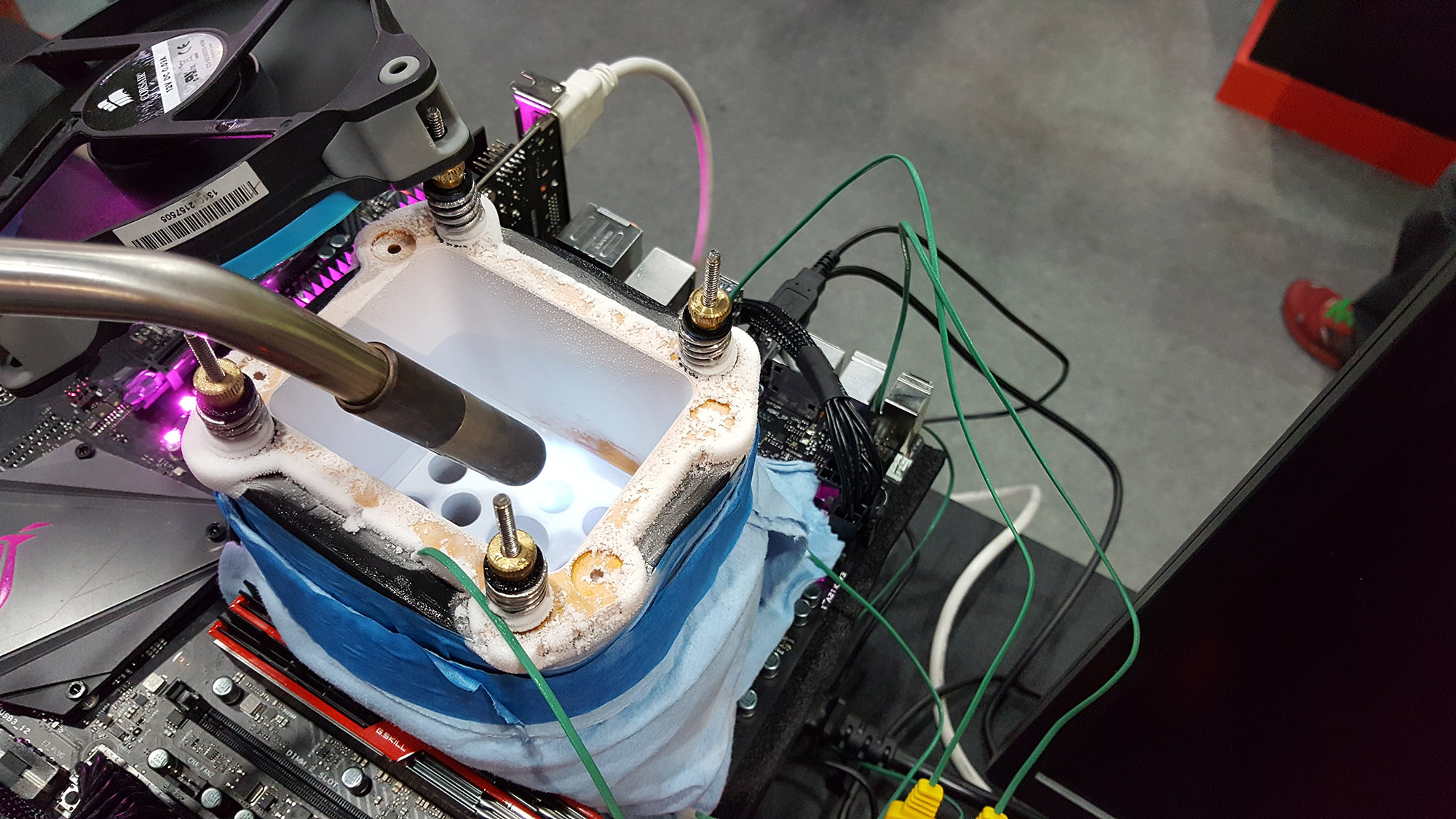
We slowly increased CPU frequency by 100 MHz, noting where we crashed, and trying that speed again with more voltage. We pushed our Kaby Lake CPU to 7 GHz, but even with a good bump of extra voltage it would crash running a benchmark load. At 6.9 GHz, however, we were stable. At that point we started seeing what kind of benchmark scores we could hit, and played around with higher memory speeds and other tweaks to increase that score.
Nothing went wrong, but identifying problems is one of the most important skills for a pro overclocker. We had two temperature readings to go by: one at the base of the cooling pot, and the other right next to the CPU.
Liquid nitrogen overclocking's really not much different than any other enthusiast PC activity. Which means: you do a lot of troubleshooting.
"Why is this important? Well, the thermal interface between the puck and the CPU needs to be optimal for us to control the temperatures of the CPU itself effectively," Plaisier says. "Sometimes you can have the contact between the pot and the CPU unstable. We call it thermal paste cracking. When that happens, it means our overclocking will be very ineffective. It will mean that once we throw a workload at it, the CPU temperature will rise very quickly, and the pot's temperature will stay the same. So you have no control over your system anymore. By comparing the delta between the two temperatures, we know, okay the IHS temperature is very high, and the pot temperature is very low, we have a problem, and we need to reinstall the entire system again."
As long as the delta remains fairly small, say 20 degrees celsius or so, and the two numbers trend in the same direction, everything's working as it should be. Plaisier says it is possible to recover from a thermal paste crack by raising the temperature, letting it re-settle and then lowering again. But most likely, you'll have to take everything apart, reapply thermal paste, and start again. Patience is an overclocker's best friend.
"When you have a situation where you go back in the OS and it crashes immediately, and then you reboot and it goes into the OS and works fine and can run benchmarks but crashes unexpectedly, you might have a condensation issue around your system," Plaisier notes. "So very experienced overclockers would then realize, okay, hold on, I'm having random issues. I don't understand what's going on right now. I need to warm up, dismantle, try again. Inexperienced overclockers would try to force things. Oh, maybe my voltage is too low, or my frequency is too high."
Thankfully there was no panic in my extreme overclocking session, just the experience of taking a CPU to 7 GHz for the first time. That may not quite be world record material, but hey: not bad for a first timer.

Wes has been covering games and hardware for more than 10 years, first at tech sites like The Wirecutter and Tested before joining the PC Gamer team in 2014. Wes plays a little bit of everything, but he'll always jump at the chance to cover emulation and Japanese games.
When he's not obsessively optimizing and re-optimizing a tangle of conveyor belts in Satisfactory (it's really becoming a problem), he's probably playing a 20-year-old Final Fantasy or some opaque ASCII roguelike. With a focus on writing and editing features, he seeks out personal stories and in-depth histories from the corners of PC gaming and its niche communities. 50% pizza by volume (deep dish, to be specific).


